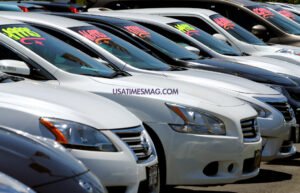The automobile industry in the United States is one of the largest and most dynamic markets globally. The term “USA auto sales” encompasses a wide range of activities, from the sale of new and used vehicles to emerging trends such as electric vehicles (EVs), online car shopping, and the integration of advanced technologies like autonomous driving systems. This comprehensive blog delves into the key aspects of USA auto sales, exploring the current market trends, consumer preferences, challenges, and future prospects.
Table of Contents
ToggleThe Current State of USA Auto Sales

Market Size and Segmentation
The U.S. automotive market is massive, with millions of vehicles sold annually. According to recent reports, approximately 13.8 million light vehicles were sold in 2023, reflecting a gradual recovery from the disruptions caused by the COVID-19 pandemic. The market is broadly segmented into:
- New Vehicle Sales: Dominated by major automakers like Ford, General Motors (GM), Toyota, and Tesla.
- Used Vehicle Sales: An increasingly significant segment, driven by affordability and supply chain challenges for new cars.
- Electric Vehicles (EVs): Experiencing exponential growth, led by brands like Tesla, Rivian, and traditional automakers transitioning to EVs.
Key Players in the Market
- Domestic Manufacturers: Companies like Ford, GM, and Stellantis (parent company of Chrysler) dominate the domestic market.
- Foreign Automakers: Toyota, Honda, and Volkswagen maintain a strong presence, with vehicles known for reliability and fuel efficiency.
- EV Manufacturers: Tesla leads the EV market, but competition is increasing with brands like Lucid Motors, Rivian, and traditional automakers introducing electric models.
Regional Variations
Sales trends vary significantly across regions:
- Urban Areas: Higher demand for EVs and hybrid vehicles due to environmental concerns and government incentives.
- Rural Areas: Preference for pickup trucks and SUVs, reflecting utility and rugged terrain requirements.
Trends Shaping USA Auto Sales

Shift to Electric and Hybrid Vehicles
The transition to electric and hybrid vehicles is one of the most significant trends in recent years. Key factors driving this shift include:
- Government Incentives: Tax credits and rebates for EV buyers.
- Infrastructure Development: Expansion of charging networks by companies like Electrify America and Tesla.
- Environmental Awareness: Growing consumer demand for sustainable transportation options.
Digital Transformation
The rise of online platforms like Carvana and Vroom has revolutionized the car-buying experience. Consumers can now:
- Browse inventory online.
- Get financing approvals.
- Schedule test drives and home deliveries.
Advanced Technologies
Modern vehicles are increasingly equipped with advanced features:
- Autonomous Driving: Tesla’s Autopilot and GM’s Super Cruise lead the market.
- Connected Cars: Vehicles with internet access, enabling features like remote diagnostics and over-the-air updates.
- Safety Features: Advanced driver-assistance systems (ADAS) such as adaptive cruise control and lane-keeping assist.
Supply Chain Challenges
Global supply chain disruptions, particularly semiconductor shortages, have impacted production and sales. While the situation is improving, it has led to:
- Higher vehicle prices.
- Longer wait times for new car deliveries.
- Increased demand for used vehicles.
Challenges in the USA Auto Sales Market

Rising Costs
Inflation and increased raw material costs have driven up vehicle prices. In 2023, the average transaction price for a new car exceeded $48,000, making affordability a major concern for consumers.
Environmental Regulations
Stricter emission standards and fuel efficiency requirements pose challenges for traditional internal combustion engine (ICE) vehicles.
Competition and Market Saturation
The growing number of automakers and new entrants in the EV space intensify competition, requiring innovative marketing and competitive pricing strategies.
Future Outlook for USA Auto Sales
Growth of Electric Vehicles
The EV market is expected to grow significantly, with projections indicating EVs will account for 40-50% of new vehicle sales by 2030. Factors contributing to this growth include:
- Lower battery costs.
- Improved vehicle range.
- Broader model availability across segments.
Autonomous Vehicles
The development of self-driving technology holds immense potential to reshape the auto industry. Companies like Waymo, Tesla, and Cruise are leading in this space, focusing on safety and regulatory approvals.
Subscription-Based Ownership Models
Car subscription services are gaining traction, offering flexibility and convenience compared to traditional ownership. Brands like Volvo and Porsche have already launched subscription programs.
Sustainability Initiatives
Automakers are increasingly focusing on sustainability:
- Using recycled materials in manufacturing.
- Achieving carbon neutrality in operations.
- Partnering with renewable energy providers.
Conclusion
The USA auto sales market is undergoing a transformative phase, driven by technological advancements, changing consumer preferences, and environmental considerations. While challenges such as rising costs and supply chain disruptions persist, the future holds exciting possibilities with the growth of electric and autonomous vehicles.
For consumers, the evolving landscape offers a wider range of choices and innovative purchasing options. For automakers, it presents an opportunity to innovate and align with sustainable practices. As the industry continues to adapt and grow, USA auto sales remain a pivotal barometer of economic activity and technological progress.
Whether you are a prospective buyer, an industry enthusiast, or a stakeholder, staying informed about these trends is essential to navigating the dynamic world of USA auto sales.
FAQs about USA Auto Sales
What are the current trends in U.S. auto sales?
Recent data indicates a rebound in U.S. auto sales. In December 2024, new vehicle sales were projected to rise by 7.3%, reaching approximately 1.52 million units. This increase is attributed to deeper discounts from automakers and dealers, despite challenges like high interest rates.
How are electric vehicles (EVs) performing in the U.S. market?
Consumer interest in electric vehicles has seen a slight decline. Only 25% of new car buyers are considering an EV for their next purchase, a 2% decrease from the previous year. Additionally, Tesla’s share of EV sales has diminished in 2024.
What factors are influencing current auto sales in the U.S.?
Several factors are impacting U.S. auto sales:
-
- Interest Rates: High interest rates are discouraging some buyers, affecting overall sales.
-
- Consumer Preferences: There’s a notable demand for crossovers and pickup trucks, with consumers gravitating towards more affordable models like compact pickup trucks and SUVs.
-
- Economic Indicators: Auto sales are a significant component of retail sales and consumer spending, reflecting the health of the economy.
How have recent economic conditions affected U.S. auto sales?
Economic factors such as inflation and high vehicle prices have influenced consumer behavior. In August 2024, U.S. auto sales declined by 4.4% due to high interest rates and a slower economy. However, subsequent months have shown signs of recovery, indicating resilience in consumer demand.
What is the forecast for U.S. auto sales in 2025?
Projections suggest that U.S. auto sales will reach 16.18 million units in 2025, marking a 1.2% increase from 2024. However, affordability issues are expected to persist, potentially influencing consumer purchasing decisions.
How can consumers navigate the current auto market effectively?
To make informed decisions in the evolving auto market, consumers should:
-
- Research Extensively: Stay updated on market trends and vehicle options.
- Consider Financing Options: Be aware of current interest rates and explore various financing avenues.
- Assess Personal Needs: Choose vehicles that align with individual requirements and budget constraints.
By staying informed and considering these factors, consumers can better navigate the complexities of the U.S. auto market in 2025.

